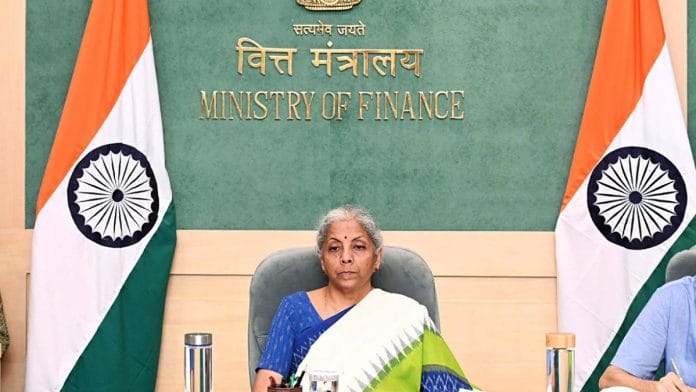The Economic Survey 2023-24 presents a bright picture of the Indian economy in the face of geopolitical challenges. Growth has remained strong, headline inflation has eased, fiscal deficit has narrowed, and trade deficit in FY24 was lower than the previous year.
For the current year, the Survey projects the Indian economy to grow at 6.5-7 percent. This seems to be a conservative estimate. In June, the RBI had revised its growth forecast for the current year from 7 to 7.2 percent. The key concern underlying the Survey’s conservative estimate is that private capital formation could turn cautious this year due to fears of cheaper imports from countries that have excess capacity.
Jobs and skill creation, addressing the bottlenecks faced by MSMEs, deepening the corporate bond market, maximising agriculture sector potential, tackling inequality and improving health quality of the young population are some of the key policy areas highlighted by the Survey to improve India’s medium-term growth outlook. There are also important sector-level recommendations worthy of consideration.
Private investment must take the baton forward
The Survey notes that public capital formation has supported growth for several years. It is time for the private sector to take the baton from the public sector and carry the investment momentum forward. While the private sector non-financial gross fixed capital formation (a proxy for private investment) has picked up in recent years, the composition of this investment is a cause for concern. Private sector investment in machinery and equipment has grown at a slower pace as compared to investment in dwellings, buildings and structures. The former is critical for catalysing growth on a sustainable basis.
Outlining the growth strategy for Amrit Kaal, the survey reiterates the importance of private sector investment particularly in the non-residential segments such as machinery, equipment, structures, software and R&D. There is a significant scope to enhance private investment while the government focuses on creating an enabling environment for investments to flourish.
Financing for investment beyond banks
Given the scale of investment needed to foster a sustained growth path, India needs to have multiple financing options. The Economic Survey has pressed for an active corporate bond market as a source of long-term funds for companies. The size of the Indian corporate bond market when expressed as a share of GDP is small compared to other Asian markets. It is dominated by highly rated issuers and is constrained by a narrow investor base.
Typically in advanced countries, corporate bond markets cater to the financing needs of large companies while banks meet the credit requirements of small and macro enterprises. Development of a deep and liquid corporate bond market with a diversified investor base will enable banks to focus on the financing needs of small enterprises.
Concessions and exemptions must be phased out
Micro, Small and Medium Enterprises (MSMEs) play a pivotal role as job providers and exporters. But they continue to grapple with extensive regulation and compliance burdens. The Survey makes a case for easing compliance requirements alongside improving access to affordable and timely credit for MSMEs. Licensing, inspection, and compliance burdens crimp the ability of MSMEs to grow to their full potential and hold them back from creating job opportunities. Particularly, the Survey highlights the unintended effects of threshold-based incentives and exemptions, as they prevent MSMEs from growing in size. The Survey rightly recommends that threshold-based incentives must have sunset clauses. These incentives should give way to a single-window mechanism for clearances.
Crop diversification, focus on post-harvest infrastructure
The Survey outlines interventions to improve agricultural performance and farmers’ income. To ensure sustainable agricultural growth, the Survey advocates promoting crop diversification towards oilseeds, pulses, and horticulture. It suggests that the MSP could be redesigned to encourage crop diversification. To boost farmers’ income and the GVA in agriculture, greater emphasis should be placed on allied activities such as animal husbandry, dairying, and fishing.
The Statistical Report on the Value of Output from Agriculture and Allied Sectors has shown that the share of crops in the Gross Value of Output of Agriculture and Allied Activities has gradually declined from 2011-12 to 2022-23. Clearly, promoting diversification will improve agricultural performance.
To ensure better incomes for farmers, the Survey recommends a greater focus on marketing and post-harvest infrastructure. This will reduce wastage of agricultural output and ensure better prices for farmers. The Survey also notes that there is scope for increased private sector participation in these areas.
Avenues for job creation
The Survey has provided a detailed overview on the vexed issue of job creation. While construction has provided jobs, these are mostly informal and low paid and job creation in manufacturing has remained subdued. It has highlighted the need for job avenues for the labour force leaving agriculture.
Based on assumptions about the worker population ratio, the Survey estimates that the Indian economy needs to generate 7.85 million jobs annually until 2030 in the non-farm sector. Besides government support in the form of schemes like the PLI and Mudra, there is a need to identify new avenues for job creation. The Survey has emphasised the role of the agro-processing sector in providing large-scale job opportunities for rural youth and women.
The Survey stresses the need for a well-developed care economy in India in the backdrop of the rise in the country’s ageing population in the next 25 years. The benefits of developing a care economy are two-fold. First, it will increase the female labour force participation rate, which is significantly lower than the aggregate labour force participation rate. Second, it can be a promising sector for job creation and will reduce the share of unpaid care work by working age women.
The Survey acknowledges that the path towards Viksit Bharat would have to be charted amid geo-political fragmentation and climate change.
Radhika Pandey is associate professor at National Institute of Public Finance and Policy (NIPFP). She tweets @Radhikaskp. Views are personal.
(Edited by Prashant)







India’s path to becoming a developed country is paved with thorns of socialism.